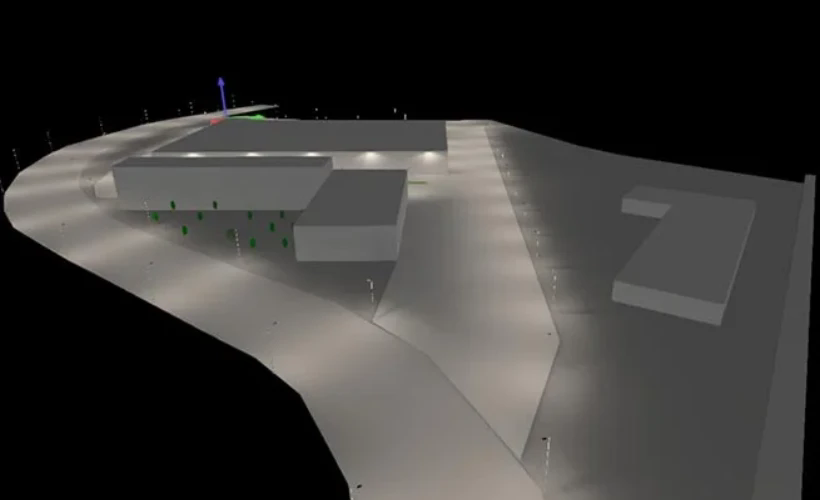This article summarizes essential formulas commonly used in solar street light design, integrating national standards and practical case studies from various papers:
Formula:
Eavg = (N × Φ × U × K) / A
● Parameter Description:
● N: Number of fixtures
● Φ: Total luminous flux per lamp (lm)
● U: Utilization factor (0.4-0.6)
● K: Maintenance factor (0.7-0.8)
● A: Road area (m2) = Road width × Lamp spacing
Example:
6m wide road, lamp spacing 30m, using 10,000 lm LED, one-sided lighting:
Eavg ≈ (1 × 10,000 × 0.5 × 0.75) / (6 × 30) ≈ 20.8 lx

Formula:
Ppv = Qday / (Hpeak × ηsys)
● Parameter Description:
● Qday = PLED × Twork (Daily energy consumption, Wh)
● Hpeak: Local annual average peak sunlight hours (check meteorological data, e.g., Beijing 4.5h)
● ηsys: System efficiency (0.6-0.75, including line losses, controller losses)
Example:
Load power 80W, daily operation 10h, Shanghai Hpeak=3.8h:
Ppv ≈ (80 × 10) / (3.8 × 0.65) ≈ 324 W
Formula:
C = (Qday × D) / (DOD × ηbat × Vsys)
● Parameter Description:
● D: Number of consecutive cloudy days (usually 3-5 days)
● DOD: Depth of discharge (0.5 for lead-acid batteries, 0.8 for lithium batteries)
● ηbat: Charge/discharge efficiency (0.85-0.95)
● Vsys: System voltage (12V/24V)
Example:
Daily consumption 800Wh, 24V system, 3 days backup, lithium battery:
C ≈ (800 × 3) / (0.8 × 0.9 × 24) ≈ 138.9 Ah → Choose 150Ah battery
Formula:
θ = φ + (5° to 15°)
● Parameter Description:
● φ: Local geographical latitude
● Winter optimization: latitude +10°~15°, summer optimization: latitude -5°
Example:
Nanjing latitude 32°, fixed bracket tilt angle set at 37° (32°+5°) to improve winter power generation.
Formula:
F = 0.61 × v2 × A
● Parameter Description:
● v: Maximum wind speed (m/s)
● A: Wind-facing area of the photovoltaic panel (m2)
Example:
Panel area 2m2, design wind speed 30m/s:
F = 0.61 × (30)2 × 2 = 1098 N
Need to verify the wind resistance of the lamp pole and foundation.
Formula:
Vmp = Vmp(STC) × [1 + α × (T – 25)]
● Parameter Description:
● α: Temperature coefficient (approximately -0.35%/°C for monocrystalline silicon)
● T: Actual operating temperature (°C)
Example:
Nominal component voltage 18V, operating temperature 60°:
Vmp ≈ 18 × [1 – 0.0035 × (60-25)] ≈ 15.3 V
Formula:
ΔV = Nseries × α × ΔT × Vmp(STC)
● Example:
● 3 series-connected components, each Vmp=30V, temperature difference 35°:
● ΔV ≈ 3 × (-0.0035) × 35 × 30 ≈ -11V
● Need to adjust the MPPT voltage range.
Empirical Formula:
Ppv(opt) = 1.2 × Ppv
● Consider shadowing, dust loss (efficiency reduction of 10-20%)
● When paralleling multiple components, increase bypass diodes to reduce hotspot effects.
| Parameter | Reference Value | Standard Basis |
|---|---|---|
| Illuminance uniformity U0 | ≥0.4 (main road) | CJJ45-2015 Road Lighting Standards |
| Component tilt angle error | ≤±3° | GB/T 9535 Photovoltaic Module Standards |
| Battery cycle life | ≥1500 times (lithium battery) | GB/T 22473 Energy Storage Standards |
| Wind resistance rating | ≥12 levels (33m/s) | GB 50009 Building Load Code |
Note: Actual design should be combined with PVsyst simulations and DIALux lighting simulations, and validated through field tests.

Tel: +86-136 3116 6703 / +86-136 3111 8767
Email: sales@yuanfongsolar.com / victor@yuanfongsolar.com
Website: https://www.yuanfongsolar.com
Add: No.96 Xinxing Road, Jianghai District, Jiangmen City, Guangdong Province, China.
Copyright © Jiangmen Yuanfeng Lighting Appliance Co.,Ltd. All Rights Reserved. 粤ICP备2025395080号 Sitemap XML